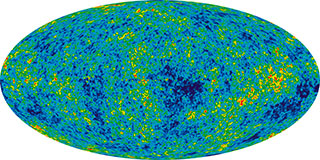How cold is intergalactic space?
1 Answer
Explanation:
According to the big bang theory, immediately after the universe began, everything existed as a nearly uniform plasma that filled the universe. This plasma then cooled for hundreds of thousands of years. Eventually it cooled enough for the atomic nuclei of the primordial elements, hydrogen, helium, and lithium, to capture electrons and become neutral. The photons that were released were effectively blackbody radiation from the early universe
Since then, these photons have been travelling freely across the universe. As the universe expands, these photons are stretched, and the light from the beginning of the universe becomes red shifted. The WMAP probe has observed this cosmic microwave background, or CMB, and found it to be almost perfectly uniform in all directions.
 http://map.gsfc.nasa.gov/media/121238/index.html
http://map.gsfc.nasa.gov/media/121238/index.html
WMAP's careful measurement has revealed that the peak wavelength of the blackbody curve is about

